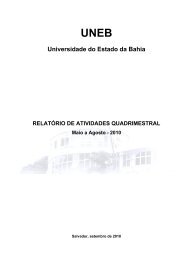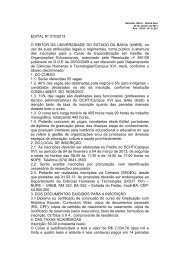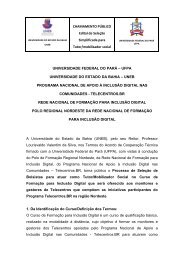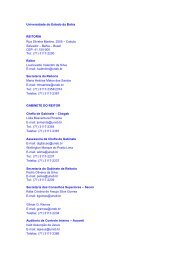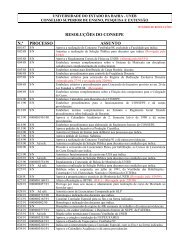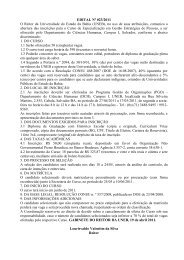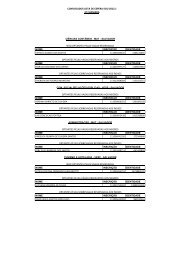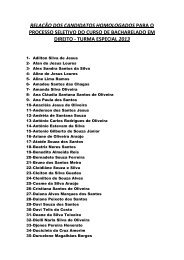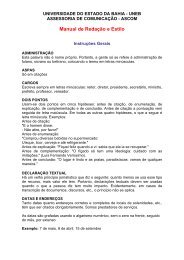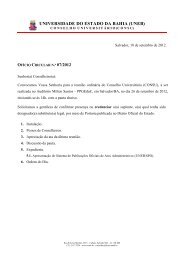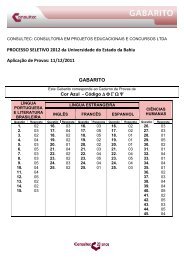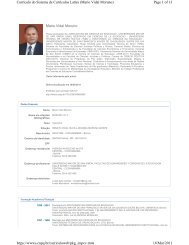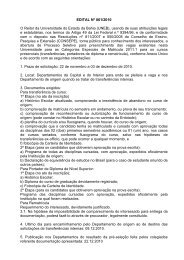Revista da FAEEBA Educação e Contemporaneidade - Uneb
Revista da FAEEBA Educação e Contemporaneidade - Uneb
Revista da FAEEBA Educação e Contemporaneidade - Uneb
You also want an ePaper? Increase the reach of your titles
YUMPU automatically turns print PDFs into web optimized ePapers that Google loves.
ed the right to vote. In 1790, Congress passed<br />
a bill limiting naturalization to “free white (male)<br />
citizens,” claiming itself a democracy while systematically<br />
denying the rights of citizenship to<br />
both people of color and women. It took another<br />
75 years before slavery officially ended –<br />
and almost a century beyond that before racial<br />
segregation laws in the South were ruled unconstitutional.<br />
Mexicans incorporated into the<br />
U.S. after the Mexican War of 1848 soon lost<br />
rights granted them in the Treaty of Gua<strong>da</strong>lupe<br />
Hi<strong>da</strong>lgo, and were quickly overwhelmed numerically<br />
and ultimately subjugated by whites flooding<br />
into California in search of gold. Others<br />
fared no better (TAKAKI, 1993). Native Americans<br />
became a conquered people and suffered<br />
the consequences of oftentimes-genoci<strong>da</strong>l<br />
policies. Chinese workers who struggled alongside<br />
Mexicans to complete the nation’s first<br />
transcontinental railroad by 1869, found the open<br />
racism they encountered in their <strong>da</strong>y-to-<strong>da</strong>y lives<br />
codified in the 1882 Chinese Exclusion Act<br />
that forbid further immigration from China. Antimiscegenation<br />
laws (forbidding marriage across<br />
racial lines) were on the books of many states<br />
as late as 1967, until the Supreme Court belatedly<br />
declared them unconstitutional.<br />
Being “American” had quickly come to be<br />
constructed as being “white”. Newly arrived<br />
Europeans <strong>da</strong>nced along racial border lines. The<br />
religious and cultural “otherness” of the Irish,<br />
arriving in large numbers in the mid-1800s, and<br />
the cultural and “racial” differences of southern<br />
and eastern European immigrants, who poured<br />
into eastern cities between the 1880s and<br />
1910s 9 , made them suspect. While most settled<br />
in urban areas in ethnic enclaves, maintaining<br />
their native languages and customs, they<br />
were under tremendous pressure to abandon<br />
them. Racist and prejudicial attitudes of the “oldtimers”<br />
were further legitimated by many scientists’<br />
arguments for the extant social hierarchy<br />
being grounded in innate differences. Madison<br />
Grant, a highly regarded anthropologist of the<br />
1920s, for instance argued that the:<br />
… new immigration contained a large and increasing<br />
number of the weak, the broken, and the<br />
mentally crippled of all races drawn from the lo-<br />
Ellen Bigler<br />
west stratum of the Mediterranean basin…. The<br />
whole tone of American life, social, moral, and<br />
political, has been lowered and vulgarized by…<br />
human flotsam. (HANDLIN, 1957, p.93-94, cited<br />
in: SANTA ANA, 2002, p.274)<br />
Mobility<br />
In a relatively short time, however, these<br />
populations moved from being viewed as questionably<br />
“white” to being accepted as part of<br />
the larger American community (DILEONAR-<br />
DO, 1992). The new European immigrants and<br />
their descen<strong>da</strong>nts benefited from a confluence<br />
of factors that worked to reduce their segregation<br />
and identity with their homeland cultures.<br />
Significantly, there was a steep decline in immigration<br />
from Europe beginning in the late 1910s,<br />
as nativist sentiments led to restrictive immigration<br />
policies designed to keep out the “unassimilables.”<br />
This meant less replenishment of<br />
ethnic communities, a phenomenon furthered by<br />
the low numbers of immigrants arriving during<br />
the Great Depression and World War II eras.<br />
The children of immigrants, meanwhile, mixed<br />
with native-born children in schools, factories,<br />
and the military. Factory jobs that did not require<br />
education were widely available. Their significant<br />
voting power was courted by city<br />
political machines. Federal legislation supporting<br />
unionization in the 1930s and 1940s ensured<br />
that many blue-collar jobs paid a living wage.<br />
A booming World War II economy, the U.S.<br />
government-funded post-war GI Bill that provided<br />
free college educations for returning veterans,<br />
an expanding economy and higher<br />
education system, and an expanded middle class<br />
in the 1950s and 1960s 10 all worked to their<br />
9 Both the Irish and the southern and eastern European<br />
populations were considered racially “other” and a threat<br />
to the assumed superiority of the (white) American stock.<br />
See for instance Roediger (1991) and Gould (1981) on thendominant<br />
social constructions of race and how these groups<br />
negotiated and contested the boun<strong>da</strong>ries of the racial<br />
constructions they encountered in the U.S.A.<br />
10 See American Conversations: Puerto Ricans, White<br />
Ethnics, and Multiculturalism (BIGLER, 1999) for a<br />
summary of the differing experiences and thus different<br />
outcomes for white U.S. Americans and Puerto Ricans in<br />
the 20th century.<br />
<strong>Revista</strong> <strong>da</strong> <strong>FAEEBA</strong> – <strong>Educação</strong> e Contemporanei<strong>da</strong>de, Salvador, v. 15, n. 25, p. 239-257, jan./jun., 2006 243



